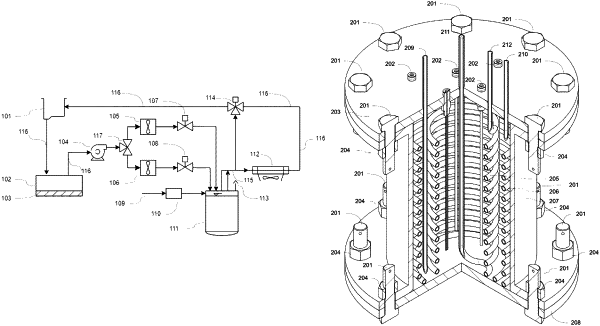| CPC H05K 7/20381 (2013.01) [H05K 7/20254 (2013.01); H05K 7/20263 (2013.01); H05K 7/20272 (2013.01); H05K 7/20409 (2013.01)] | 6 Claims |

|
1. An electronic device heat dissipation system, comprising:
a cooling circulation pipeline, a heat dissipation cold plate, an energy storage heat exchanger, a crystal powder feeder, and a radiator;
wherein the cooling circulation pipeline is configured to flow out fluid, and the fluid is configured to flow sequentially through the heat dissipation cold plate and the energy storage heat exchanger, and then optionally pass through the radiator; and the heat dissipation cold plate is fixed on an electronic device (103);
wherein the energy storage heat exchanger is filled with an energy storage medium, the energy storage medium is capable of absorbing heat and melting as well as solidifying and regenerating, and the crystal powder feeder is configured to input crystal powder of the energy storage medium to improve a solidification and regeneration speed of the energy storage medium;
wherein the energy storage heat exchanger comprises: a heat exchanger shell, a first coil, and a second coil; the first coil, the second coil and the energy storage medium are all disposed inside the heat exchanger shell, the first coil and the second coil form a parallel structure, and the fluid is configured to flow through the first coil and the second coil;
wherein a fluid output end of the energy storage heat exchanger is connected to an output pipeline and the radiator, the radiator and the output pipeline form a parallel structure, the output pipeline is connected to an input end of a three-way valve, the radiator is connected to another input end of the three-way valve, and an output end of the three-way valve is connected to the cooling circulation pipeline;
wherein upper parts of the first coil and the second coil extend outward from the energy storage heat exchanger and are fixed on a top orifice plate, the upper part of the first coil defines a first inlet and a first outlet, and the upper part of the second coil defines a second inlet and a second outlet;
wherein the first inlet is connected to a first flow meter, the first flow meter is connected to an output end of a tee joint, the second inlet is connected to a second flow meter, the second flow meter is connected to another output end of the tee joint, an input end of the tee joint is connected to a pump, the second inlet and the second outlet forms a circuit, the circuit is connected to the output pipeline, and the output end of the three-way valve is connected to a reservoir;
wherein the fluid for transferring heat is configured to pass through the tee joint and divide into two paths, and the two paths of the fluid are configured to enter the first coil and the second coil separately, pass through the radiator or bypass the radiator under different working modes, and then return to the reservoir to complete circulation; and the different working modes are switched by control of the three-way valve based on detected temperature; and
wherein the energy storage medium is a sugar alcohol phase change material (PCM).
|